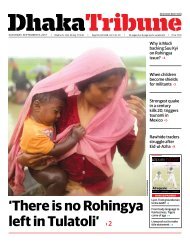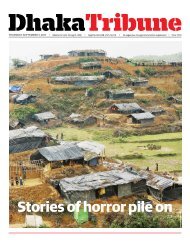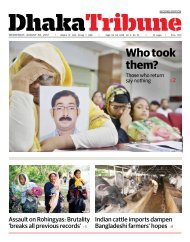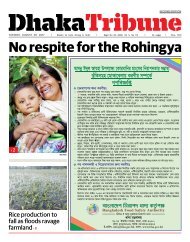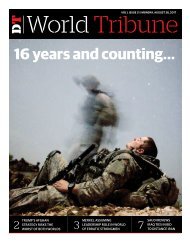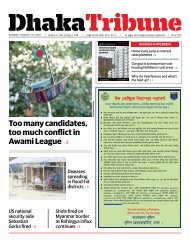e_Paper_Thursday_December 30, 2016
You also want an ePaper? Increase the reach of your titles
YUMPU automatically turns print PDFs into web optimized ePapers that Google loves.
22<br />
FRIDAY, DECEMBER <strong>30</strong>, <strong>2016</strong><br />
DT<br />
Opinion<br />
Oppressors and exploiters, be careful<br />
The plight of the Santals is nothing if not heart-wrenching<br />
• Zahir Ahmed and Fiaz Sharif<br />
It’s winter in late November<br />
<strong>2016</strong>. We are accompanied by<br />
a local Santal young man to<br />
visit the Gobindaganj Santal<br />
villages since the massacre in early<br />
November. There is a sense of an<br />
external intervention instantly<br />
from the wire fence around the<br />
crop fields.<br />
Near the temporary<br />
accommodation given to the<br />
evicted villagers, are posters<br />
written in both Bangla and Santal<br />
languages. Whilst not explained,<br />
these posters have statements<br />
which convey the nature of<br />
dissatisfaction -- they are merely<br />
another form of protest.<br />
While the posters are a visual<br />
representation of the Santal, taken<br />
from their muddy house walls<br />
around the villages, the messages<br />
reflect and convey the historical<br />
roots of their struggle, focusing<br />
on some elements of the glorious<br />
historical movements led by<br />
heroes like Kanu and Sidhu whilst<br />
appealing to the government to<br />
give their land back.<br />
They read: “It is our land, we<br />
used to own it” … “Honorable<br />
administration, find our<br />
disappeared individuals” …<br />
“Stop filing cases against the<br />
Santals” … “It is impossible to stop<br />
indigenous peoples’ movement<br />
with a gun.”<br />
Some slogans are written in<br />
in the Santali language: “Diku<br />
pera janum jati Husiar Husiar”<br />
(the oppressors and exploiters,<br />
be careful); “Sidhu kanu rakapen,<br />
hule hul hule hul, bagda farm hasa<br />
lagit, Hule hul hule hul” (wake up<br />
the successors of Sidhu-Kanu,<br />
wake up the inhabitants of Bagda<br />
farm).<br />
Not surprisingly, the legacy of<br />
the Santals’ current protest is more<br />
complex than the official version<br />
would have us believe.<br />
Some Santal farmers showed<br />
their anger with a grimace when<br />
we wanted to talk more. They<br />
said that the whole affair is a bit<br />
disappointing -- they have been<br />
frequently asked similar questions<br />
by numerous journalists and<br />
activities. Nothing was beneficial<br />
to them. They argue: “All are<br />
with the leaders and the sugar<br />
mill authority. Do you have a<br />
solution?”<br />
Some villagers told us that<br />
they had lost household property.<br />
When the district administration<br />
sent food as relief, the protestors<br />
did not receive it although they<br />
had been hungry for three to four<br />
days.<br />
A group of individuals gave an<br />
Will the Santals ever get their land back?<br />
eloquent description of the recent<br />
massacre: “The political thugs<br />
are obsessed with death and see<br />
it around every corner and our<br />
blood drips from every plant in the<br />
field. The only way to live in such<br />
a terrifying world is to leave our<br />
ancestral lands.”<br />
Mongol Mardee is standing<br />
beside the wire fence, looking at<br />
the paddy fields with blood-thirsty<br />
eyes. We have walked the short<br />
distance here from his demolished<br />
house, with its makeshift<br />
dwelling, where we saw that many<br />
others have been compelled to<br />
lead sub-human lives as attackers<br />
have vandalised and set their<br />
homes ablaze, looted everything,<br />
including food grains, valuable<br />
things, and domestic animals.<br />
Mardee doesn’t like living as<br />
a refugee in his own ancestral<br />
land. He says: “Seeing the wire<br />
fence and giant machine which<br />
has harvested their green paddy,<br />
brings indescribable pain. We met<br />
some mill officials near the fields.<br />
We have asked them a very simple<br />
question: ‘Why are the officials in<br />
the field?’ They replied that the<br />
court had ordered them to harvest<br />
the paddy as early as possible.”<br />
The story highlights how, within<br />
the minority context, the official<br />
statement is motivated. Yet,<br />
whilst land-grabbing politics is<br />
evident, efforts are made to ignore<br />
them. The hidden political view<br />
is rendered apolitical via the<br />
anodyne language and benevolent<br />
efforts. Within this context,<br />
the apparently philanthropic<br />
transcripts of the players involved<br />
in the massacre can be understood<br />
as a form of governance in which<br />
the entitlement rights of the<br />
minority that cause the massacre<br />
are not interrogated, the status<br />
quo remains unquestioned, and<br />
neo-liberal ideologies asserted.<br />
On our return to Dhaka, we<br />
stopped again in front of the wire<br />
fence. Hemonto Tudu of Madarpur<br />
squats patiently in front of the<br />
fence, staring through the barbed<br />
wire into the paddy fields.<br />
It’s a new world to him -- new<br />
management with giant machines<br />
to harvest, a new place where<br />
police are deployed, mill workers<br />
turned into agricultural labourers<br />
with trousers and helmets, and<br />
security regulations strictly<br />
upheld.<br />
A placard near the entrance<br />
declares the area protected.<br />
Further on, a big power tiller is<br />
neatly parked next to paddy straws<br />
to till the land for sugar cane<br />
plantation.<br />
This is a new world to Hemonto,<br />
one beyond his imagination.<br />
He was narrating his past days<br />
when he used to pass this field<br />
across narrow muddy paths that<br />
led him into his Joypur home<br />
village with his cattle. It is because<br />
of this contrast that Hemonto is<br />
MEHEDI HASAN<br />
While the posters are visual representation of the Santal, taken from<br />
their muddy house walls around the villages, the messages reflect<br />
and convey the historical roots of their struggle<br />
here. He could not stop crying<br />
about the recent massacre, about<br />
how brutally demolished were the<br />
houses.<br />
He is now helpless, hanging<br />
around the wire fences with his<br />
matted hair and lunatic eyes.<br />
Before we part towards<br />
Gobindaganj, and Hemonto Tudu<br />
heads back to his temporary<br />
shelter, he takes our hands and<br />
makes a request that, wherever we<br />
have a chance to do something for<br />
them in Dhaka, we should.<br />
His words haunted us as we<br />
later sped down a tarmac road to<br />
Dhaka. •<br />
Dr Zahir Ahmed is a Professor,<br />
Department of Anthropology,<br />
Jahangirnagar University. Fiaz Sharif is<br />
an MPhil Researcher, Department of<br />
Anthropology, Jahangirnagar University.




